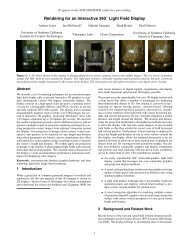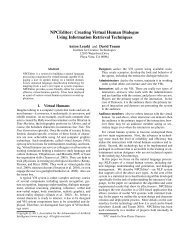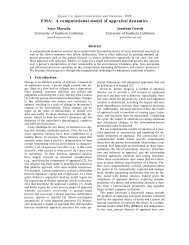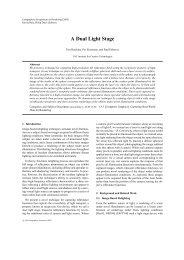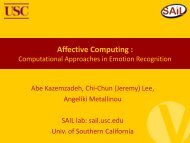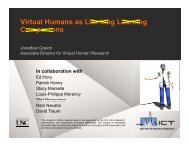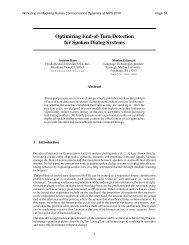Effect of Illumination on Automatic Expression Recognition: A Novel ...
Effect of Illumination on Automatic Expression Recognition: A Novel ...
Effect of Illumination on Automatic Expression Recognition: A Novel ...
You also want an ePaper? Increase the reach of your titles
YUMPU automatically turns print PDFs into web optimized ePapers that Google loves.
<str<strong>on</strong>g>Effect</str<strong>on</strong>g> <str<strong>on</strong>g>of</str<strong>on</strong>g> <str<strong>on</strong>g>Illuminati<strong>on</strong></str<strong>on</strong>g> <strong>on</strong> <strong>Automatic</strong> Expressi<strong>on</strong> Recogniti<strong>on</strong>:<br />
A <strong>Novel</strong> 3D Relightable Facial Database<br />
Giota Stratou Abhijeet Ghosh Paul Debevec Louis-Philippe Morency<br />
Institute for Creative Technologies, University <str<strong>on</strong>g>of</str<strong>on</strong>g> Southern California<br />
{ stratou, ghosh, debevec, morency} @ict.usc.edu<br />
Abstract— One <str<strong>on</strong>g>of</str<strong>on</strong>g> the main challenges in facial expressi<strong>on</strong><br />
recogniti<strong>on</strong> is illuminati<strong>on</strong> invariance. Our l<strong>on</strong>g-term goal is<br />
to develop a system for automatic facial expressi<strong>on</strong> recogniti<strong>on</strong><br />
that is robust to light variati<strong>on</strong>s. In this paper, we introduce a<br />
novel 3D Relightable Facial Expressi<strong>on</strong> (ICT-3DRFE) database<br />
that enables experimentati<strong>on</strong> in the fields <str<strong>on</strong>g>of</str<strong>on</strong>g> both computer<br />
graphics and computer visi<strong>on</strong>. The database c<strong>on</strong>tains 3D models<br />
for 23 subjects and 15 expressi<strong>on</strong>s, as well as photometric<br />
informati<strong>on</strong> that allow for photorealistic rendering. It is also<br />
facial acti<strong>on</strong> units annotated, using FACS standards. Using<br />
the ICT-3DRFE database we create an image set <str<strong>on</strong>g>of</str<strong>on</strong>g> different<br />
expressi<strong>on</strong>s/illuminati<strong>on</strong>s to study the effect <str<strong>on</strong>g>of</str<strong>on</strong>g> illuminati<strong>on</strong> <strong>on</strong><br />
automatic expressi<strong>on</strong> recogniti<strong>on</strong>. We compared the output<br />
scores from automatic recogniti<strong>on</strong> with expert FACS annotati<strong>on</strong>s<br />
and found that they agree when the illuminati<strong>on</strong> is<br />
uniform. Our results show that the output distributi<strong>on</strong> <str<strong>on</strong>g>of</str<strong>on</strong>g> the<br />
automatic recogniti<strong>on</strong> can change significantly with light variati<strong>on</strong>s<br />
and sometimes causes the discriminati<strong>on</strong> <str<strong>on</strong>g>of</str<strong>on</strong>g> two different<br />
expressi<strong>on</strong>s to be diminished. We propose a ratio-based light<br />
transfer method, to factor out unwanted illuminati<strong>on</strong>s from<br />
given images and show that it reduces the effect <str<strong>on</strong>g>of</str<strong>on</strong>g> illuminati<strong>on</strong><br />
<strong>on</strong> expressi<strong>on</strong> recogniti<strong>on</strong>.<br />
I. INTRODUCTION<br />
One <str<strong>on</strong>g>of</str<strong>on</strong>g> the main challenges with facial expressi<strong>on</strong> recogniti<strong>on</strong><br />
is to achieve illuminati<strong>on</strong> invariance. Prior studies show<br />
that changing the directi<strong>on</strong> <str<strong>on</strong>g>of</str<strong>on</strong>g> illuminati<strong>on</strong> can influence<br />
the percepti<strong>on</strong> <str<strong>on</strong>g>of</str<strong>on</strong>g> object characteristics such as 3D shape<br />
and locati<strong>on</strong> [1]. Relative to comm<strong>on</strong> image representati<strong>on</strong>s,<br />
changes in lighting result in large image differences. These<br />
observed changes can be larger even than when varying the<br />
identity <str<strong>on</strong>g>of</str<strong>on</strong>g> the subject [2].<br />
These studies suggest that both human and automated<br />
facial identificati<strong>on</strong> are impaired by variati<strong>on</strong>s in illuminati<strong>on</strong>.<br />
By extensi<strong>on</strong>, we expect a similar impediment to facial<br />
expressi<strong>on</strong> recogniti<strong>on</strong>. This intuiti<strong>on</strong> is strengthened by four<br />
observati<strong>on</strong>s: i) changes in facial expressi<strong>on</strong> are manifested<br />
as deformati<strong>on</strong> <str<strong>on</strong>g>of</str<strong>on</strong>g> the shape and texture <str<strong>on</strong>g>of</str<strong>on</strong>g> the facial surface,<br />
ii) illuminati<strong>on</strong> variance has been shown to influence percepti<strong>on</strong><br />
<str<strong>on</strong>g>of</str<strong>on</strong>g> shape, which c<strong>on</strong>founds face recogniti<strong>on</strong>, iii) most<br />
methods for automated expressi<strong>on</strong> recogniti<strong>on</strong> use image<br />
representati<strong>on</strong>s, features, and processing techniques similar<br />
to face recogniti<strong>on</strong> methods [3] which are also c<strong>on</strong>founded<br />
by illuminati<strong>on</strong> variance, and iv) the training set for most<br />
classifiers c<strong>on</strong>sists mainly <str<strong>on</strong>g>of</str<strong>on</strong>g> uniformly lit images.<br />
While most automatic systems for facial expressi<strong>on</strong> recogniti<strong>on</strong><br />
assume input images with relatively uniform illuminati<strong>on</strong>,<br />
research such as Li et al. [4], Kumar et al. [5] and<br />
a b c d<br />
Fig. 1. A sample 3D model from ICT-3DRFE and some <str<strong>on</strong>g>of</str<strong>on</strong>g> its corresp<strong>on</strong>ding<br />
textures and photometric surface normal maps. First row, a) diffuse<br />
texture, b) specular texture, c) diffuse (red channel) normals, d) specular<br />
normals. Sec<strong>on</strong>d row, from left to right: 3D geometry <str<strong>on</strong>g>of</str<strong>on</strong>g> a subject posing<br />
for the ”eyebrows up” expressi<strong>on</strong>; same pose rendered with texture and<br />
simple pointlights; different pose <str<strong>on</strong>g>of</str<strong>on</strong>g> the model rendered under envir<strong>on</strong>mental<br />
lighting.<br />
Toderici et al. [6] have worked toward illuminati<strong>on</strong> invariant<br />
by extracting features which are illuminati<strong>on</strong> invariant. To<br />
serve this directi<strong>on</strong> <str<strong>on</strong>g>of</str<strong>on</strong>g> research, facial databases have been<br />
assembled which capture the same face and pose under<br />
different illuminati<strong>on</strong> c<strong>on</strong>diti<strong>on</strong>s, and lately the development<br />
<str<strong>on</strong>g>of</str<strong>on</strong>g> 3D facial databases has become <str<strong>on</strong>g>of</str<strong>on</strong>g> interest, since they<br />
allow explorati<strong>on</strong> <str<strong>on</strong>g>of</str<strong>on</strong>g> new 3D features.<br />
In this paper, we introduce a novel 3D Relightable Facial<br />
Expressi<strong>on</strong> (ICT-3DRFE) database which enables studies <str<strong>on</strong>g>of</str<strong>on</strong>g><br />
facial expressi<strong>on</strong> recogniti<strong>on</strong> and synthesis. We dem<strong>on</strong>strate<br />
the value <str<strong>on</strong>g>of</str<strong>on</strong>g> having such a database while exploring the effect<br />
<str<strong>on</strong>g>of</str<strong>on</strong>g> illuminati<strong>on</strong> <strong>on</strong> facial expressi<strong>on</strong> recogniti<strong>on</strong>. First, we<br />
use the ICT-3DRFE database to create a sample database<br />
<str<strong>on</strong>g>of</str<strong>on</strong>g> images to study the effect <str<strong>on</strong>g>of</str<strong>on</strong>g> illuminati<strong>on</strong>. We use the<br />
Computer Expressi<strong>on</strong> Recogniti<strong>on</strong> Toolbox (CERT) [7] to<br />
evaluate specific Facial Acti<strong>on</strong> Units (AU) <strong>on</strong> that image set<br />
and we compare CERT output with a FACS (Facial Acti<strong>on</strong><br />
Coding System) expert coder’s annotati<strong>on</strong>s. We also compare<br />
the CERT output <str<strong>on</strong>g>of</str<strong>on</strong>g> specific expressi<strong>on</strong>s under different<br />
illuminati<strong>on</strong> to observe how lighting variati<strong>on</strong> affects its ability<br />
to distinguish between expressi<strong>on</strong>s. Sec<strong>on</strong>d, we present
an approach to factor out lighting variati<strong>on</strong> to improve<br />
the accuracy <str<strong>on</strong>g>of</str<strong>on</strong>g> automatic expressi<strong>on</strong> recogniti<strong>on</strong>. For this<br />
purpose, we employ ratio images as in the approach <str<strong>on</strong>g>of</str<strong>on</strong>g> Peers<br />
et al. [8], to transfer the uniformly-lit appearance <str<strong>on</strong>g>of</str<strong>on</strong>g> a similar<br />
face in the ICT-3DRFE database to a target face seen under<br />
n<strong>on</strong>-uniform illuminati<strong>on</strong>. In this approach, we use the ICT-<br />
3DRFE database to select a matching subject and transfer<br />
illuminati<strong>on</strong>. We evaluate if ”unlighting” a face in this<br />
way can improve the performance <str<strong>on</strong>g>of</str<strong>on</strong>g> expressi<strong>on</strong> recogniti<strong>on</strong><br />
s<str<strong>on</strong>g>of</str<strong>on</strong>g>tware. Our experiments show promising results.<br />
The remainder <str<strong>on</strong>g>of</str<strong>on</strong>g> this paper is arranged as follows: in<br />
Secti<strong>on</strong> II, we discuss the previous work <strong>on</strong> automatic facial<br />
expressi<strong>on</strong> recogniti<strong>on</strong>. We also survey the state-<str<strong>on</strong>g>of</str<strong>on</strong>g>-the-art<br />
in facial expressi<strong>on</strong> databases and menti<strong>on</strong> other face relighting<br />
techniques relevant to facial expressi<strong>on</strong> recogniti<strong>on</strong>.<br />
In Secti<strong>on</strong> III, we introduce our new ICT-3DRFE database,<br />
discussing its advantages and how it was assembled. Secti<strong>on</strong><br />
IV describes our experiment <strong>on</strong> the effect <str<strong>on</strong>g>of</str<strong>on</strong>g> illuminati<strong>on</strong> <strong>on</strong><br />
facial expressi<strong>on</strong> recogniti<strong>on</strong> using the ICT-3DRFE database.<br />
Secti<strong>on</strong> V describes our illuminati<strong>on</strong> transfer technique for<br />
mitigating the effects <str<strong>on</strong>g>of</str<strong>on</strong>g> illuminati<strong>on</strong> <strong>on</strong> expressi<strong>on</strong> recogniti<strong>on</strong>,<br />
showing how this improves AU classificati<strong>on</strong>. We<br />
c<strong>on</strong>clude with a discussi<strong>on</strong> <str<strong>on</strong>g>of</str<strong>on</strong>g> future work in Secti<strong>on</strong> VI.<br />
II. PREVIOUS WORK<br />
A. Facial Expressi<strong>on</strong> Recogniti<strong>on</strong><br />
There has been significant progress in the field <str<strong>on</strong>g>of</str<strong>on</strong>g> facial<br />
expressi<strong>on</strong> recogniti<strong>on</strong> in the last few decades. Two popular<br />
classes <str<strong>on</strong>g>of</str<strong>on</strong>g> facial expressi<strong>on</strong> recogniti<strong>on</strong> are: i) facial Acti<strong>on</strong><br />
Units (AUs) according to the Facial Acti<strong>on</strong> Coding System<br />
(FACS) proposed by Ekman et al. [10] and ii) the set <str<strong>on</strong>g>of</str<strong>on</strong>g><br />
prototypic expressi<strong>on</strong>s also defined by Ekman [11] that relate<br />
to emoti<strong>on</strong>al states including happiness, sadness, anger, fear,<br />
disgust and surprise. Systems <str<strong>on</strong>g>of</str<strong>on</strong>g> automatic expressi<strong>on</strong> recogniti<strong>on</strong><br />
comm<strong>on</strong>ly use AU analysis as a low level expressi<strong>on</strong><br />
classificati<strong>on</strong> followed by a sec<strong>on</strong>d level <str<strong>on</strong>g>of</str<strong>on</strong>g> classificati<strong>on</strong> <str<strong>on</strong>g>of</str<strong>on</strong>g><br />
AU combinati<strong>on</strong>s into <strong>on</strong>e <str<strong>on</strong>g>of</str<strong>on</strong>g> the basic expressi<strong>on</strong>s [13].<br />
Traditi<strong>on</strong>al automatic systems use geometric features such as<br />
the locati<strong>on</strong> <str<strong>on</strong>g>of</str<strong>on</strong>g> facial landmarks (corners <str<strong>on</strong>g>of</str<strong>on</strong>g> the eyes, nostrils,<br />
etc.) and spatial relati<strong>on</strong>s am<strong>on</strong>g them (shape <str<strong>on</strong>g>of</str<strong>on</strong>g> eyes, mouth,<br />
etc.) [3] [12]. Bartlett et al. found in practice that imagebased<br />
representati<strong>on</strong>s c<strong>on</strong>tain more informati<strong>on</strong> for facial<br />
expressi<strong>on</strong> than representati<strong>on</strong>s based <strong>on</strong> shape <strong>on</strong>ly [14].<br />
Recent methods focus either <strong>on</strong> solely appearance features<br />
(representing the facial texture) like Bartlett et al. [14] who<br />
use Gabor wavelets or eigenfaces, or hybrid methods, using<br />
both shape- and appearance- based features, like in the case<br />
<str<strong>on</strong>g>of</str<strong>on</strong>g> Lucey et al. which uses an Active Appearance Model<br />
(AAM) [15]. There is also a rising interest in the use <str<strong>on</strong>g>of</str<strong>on</strong>g><br />
3D facial geometry to extract expressi<strong>on</strong> representati<strong>on</strong>s that<br />
will be view and pose invariant [13].<br />
B. Facial Databases<br />
Facial expressi<strong>on</strong> databases are very important for facial<br />
expressi<strong>on</strong> recogniti<strong>on</strong>, because there is a need for comm<strong>on</strong><br />
ground to evaluate various algorithms. These databases<br />
are usually static images or image sequences. The most<br />
Fig. 2. Acquisiti<strong>on</strong> setup for ICT-3DRFE. Left: LED sphere with 156<br />
white LED lights. Right: Layout showing the positi<strong>on</strong>ing <str<strong>on</strong>g>of</str<strong>on</strong>g> the stereo pair<br />
<str<strong>on</strong>g>of</str<strong>on</strong>g> cameras and projector for face scanning.<br />
comm<strong>on</strong>ly used facial expressi<strong>on</strong> databases include the<br />
Cohn-Kanade facial expressi<strong>on</strong> database [16] which is AU<br />
coded, the Japanese Female Facial Expressi<strong>on</strong> (JAFFE)<br />
database [17], MMI database [18] which includes both still<br />
images and image sequences, the CMU-PIE database [19],<br />
with pose and illuminati<strong>on</strong> variati<strong>on</strong> for each subject, and<br />
other databases [20]. Since the introducti<strong>on</strong> <str<strong>on</strong>g>of</str<strong>on</strong>g> 3D into<br />
facial expressi<strong>on</strong> recogniti<strong>on</strong>, 3D databases have gained in<br />
popularity. The most comm<strong>on</strong> is the BU-3DFE database<br />
which includes 3D models and c<strong>on</strong>siders intensity levels <str<strong>on</strong>g>of</str<strong>on</strong>g><br />
expressi<strong>on</strong>s [21]. BU-3DFE was extended to the BU-4DFE<br />
by including temporal data [22]. The latest facial expressi<strong>on</strong><br />
databases are the Radboud Facial Database (RaFD), which<br />
c<strong>on</strong>siders c<strong>on</strong>tempt, a n<strong>on</strong> prototypic expressi<strong>on</strong> and different<br />
gaze directi<strong>on</strong>s [23], and the extended Cohn-Kanade (CK+)<br />
database, which is an extensi<strong>on</strong> <str<strong>on</strong>g>of</str<strong>on</strong>g> the older CK, is fully<br />
FACS coded and includes emoti<strong>on</strong> labels [24].<br />
Our new ICT-3DRFE database also includes 3D models,<br />
c<strong>on</strong>siders different gaze directi<strong>on</strong>s, and is AU annotated. In<br />
c<strong>on</strong>trast to the other databases, however, our ICT-3DRFE<br />
database <str<strong>on</strong>g>of</str<strong>on</strong>g>fers much higher resoluti<strong>on</strong> in its 3D models,<br />
and it is the <strong>on</strong>ly photorealistically relightable database.<br />
C. Face Relighting<br />
One <str<strong>on</strong>g>of</str<strong>on</strong>g> our ultimate goals is to factor out the effect <str<strong>on</strong>g>of</str<strong>on</strong>g><br />
illuminati<strong>on</strong> <strong>on</strong> facial expressi<strong>on</strong> recogniti<strong>on</strong>. For that, we<br />
leverage image based relighting techniques which have been<br />
extensively studied in computer graphics. Debevec et al. [26]<br />
photographs a face with a dense sampling <str<strong>on</strong>g>of</str<strong>on</strong>g> lighting directi<strong>on</strong>s<br />
using a spherical light stage and exploits the linearity<br />
<str<strong>on</strong>g>of</str<strong>on</strong>g> light transport to accurately rendering the face under<br />
any distant illuminati<strong>on</strong> envir<strong>on</strong>ment from such data. While<br />
realistic and accurate, the technique can be applied <strong>on</strong>ly to<br />
subjects captured in a light stage. Peers et al. [8] overcame<br />
this restricti<strong>on</strong> through an appearance transfer technique<br />
based <strong>on</strong> ratio images [9], allowing a single photograph <str<strong>on</strong>g>of</str<strong>on</strong>g><br />
a face to be approximately relit using light stage data <str<strong>on</strong>g>of</str<strong>on</strong>g> a<br />
similar-looking subject from a database. Ratio images have<br />
also been used to transfer facial expressi<strong>on</strong>s from <strong>on</strong>e image<br />
to another by Liu et al. [25]. A few other researchers have<br />
explored relighting methods to enhance facial recogniti<strong>on</strong>:<br />
Kumar et al. [5] uses morphable reflectance fields to augment
0 1 2 3 4 5 6 7<br />
Neutral,<br />
Eyes Closed<br />
Ex0<br />
Neutral,<br />
Eyes Open<br />
Ex4<br />
Eyebrows<br />
Up<br />
Ex5<br />
Eyebrows<br />
Down<br />
Scrunch<br />
8 9 10 11 12 13 14 15<br />
16 17 18 19 20 21 22<br />
Fig. 3.<br />
The 23 subjects <str<strong>on</strong>g>of</str<strong>on</strong>g> ICT-3DRFE database.<br />
image databases with relit images <str<strong>on</strong>g>of</str<strong>on</strong>g> the existing set, and<br />
Toderici et al. [6] uses bidirecti<strong>on</strong>al relighting.<br />
Our approach to factor out the effect <str<strong>on</strong>g>of</str<strong>on</strong>g> illuminati<strong>on</strong> from<br />
a target face is similar in principle to that <str<strong>on</strong>g>of</str<strong>on</strong>g> Peers et al. [8].<br />
Our main difference from most <str<strong>on</strong>g>of</str<strong>on</strong>g> these approaches is that<br />
while they relight a uniformly illuminated target face to a<br />
desired n<strong>on</strong>-uniform lighting c<strong>on</strong>diti<strong>on</strong>, we relight the target<br />
face image from a known n<strong>on</strong>-uniform lighting c<strong>on</strong>diti<strong>on</strong><br />
to a uniform lighting c<strong>on</strong>diti<strong>on</strong> for robust facial expressi<strong>on</strong><br />
recogniti<strong>on</strong>.<br />
III. 3D-RFE DATASET<br />
The main c<strong>on</strong>tributi<strong>on</strong> <str<strong>on</strong>g>of</str<strong>on</strong>g> this paper is the introducti<strong>on</strong> <str<strong>on</strong>g>of</str<strong>on</strong>g><br />
a new 3D Relightable Facial Expressi<strong>on</strong> Database 1 . As with<br />
any 3D database, a great advantage <str<strong>on</strong>g>of</str<strong>on</strong>g> having 3D geometry is<br />
that <strong>on</strong>e can use it to extract geometric features that are pose<br />
and viewpoint invariant. In our ICT-3DRFE database, the<br />
detail <str<strong>on</strong>g>of</str<strong>on</strong>g> the geometry is higher than in any other existing 3D<br />
database, with each model having approximately 1,200,000<br />
vertices with reflectance maps <str<strong>on</strong>g>of</str<strong>on</strong>g> 1296 × 1944 pixels. This<br />
resoluti<strong>on</strong> c<strong>on</strong>tains detail down to sub-millimeter skin pore<br />
level, increasing its utility for the study <str<strong>on</strong>g>of</str<strong>on</strong>g> geometric and 3D<br />
features. Besides high resoluti<strong>on</strong>, relightability is the other<br />
main novelty <str<strong>on</strong>g>of</str<strong>on</strong>g> this database. The reflectance informati<strong>on</strong><br />
provided with every 3D model allows the faces to rendered<br />
realistically under any given illuminati<strong>on</strong>. For example, <strong>on</strong>e<br />
could use a light probe [29] to capture the illuminati<strong>on</strong> in a<br />
specific scene to to render a face in the ICT-3DRFE database<br />
with that lighting. This property, al<strong>on</strong>g with the traditi<strong>on</strong>al<br />
advantages <str<strong>on</strong>g>of</str<strong>on</strong>g> a 3D model database (such as c<strong>on</strong>trolling the<br />
pose while rendering) enables many uses. In Secti<strong>on</strong> IV, we<br />
use our ICT-3DRFE to study the effect <str<strong>on</strong>g>of</str<strong>on</strong>g> illuminati<strong>on</strong> <strong>on</strong><br />
facial expressi<strong>on</strong>s by creating a database <str<strong>on</strong>g>of</str<strong>on</strong>g> facial images<br />
under chosen illuminati<strong>on</strong> c<strong>on</strong>diti<strong>on</strong>s and poses. Also in<br />
Secti<strong>on</strong> V, we use the database as a tool for removing<br />
illuminati<strong>on</strong> effects from facial images. Figure 1 displays<br />
a sample 3D model from the ICT-3DRFE database under<br />
different poses and illuminati<strong>on</strong>s.<br />
A. Acquisiti<strong>on</strong> Setup<br />
The ICT-3DRFE dataset introduced in this paper was<br />
acquired using a high resoluti<strong>on</strong> face scanning system that<br />
1 This database will be made publicly available at<br />
http://projects.ict.usc.edu/3drfe/<br />
Ex1 Ex2 Ex3<br />
Happiness Sadness Anger Fear Disgust Surprise<br />
Eye gaze<br />
Up<br />
Eye gaze<br />
Down<br />
Eye gaze<br />
Right<br />
Eye gaze<br />
Left<br />
Fig. 4. The 15 expressi<strong>on</strong>s captured for every subject. The <strong>on</strong>es annotated<br />
with an ”Ex” label are the expressi<strong>on</strong>s used in our experiments.<br />
employs a spherical light stage with 156 white LED lights<br />
( Figure 2A). The lights are individually c<strong>on</strong>trollable in<br />
intensity and are used to light the face with a series <str<strong>on</strong>g>of</str<strong>on</strong>g><br />
c<strong>on</strong>trolled spherical lighting c<strong>on</strong>diti<strong>on</strong>s which reveal detailed<br />
shape and reflectance informati<strong>on</strong>. An LCD video projector<br />
subsequently projects a series <str<strong>on</strong>g>of</str<strong>on</strong>g> colored stripe patterns to aid<br />
stereo corresp<strong>on</strong>dence. The face’s appearance under these<br />
c<strong>on</strong>diti<strong>on</strong>s is photographed by a stereo pair <str<strong>on</strong>g>of</str<strong>on</strong>g> Can<strong>on</strong> 1D<br />
Mark III digital cameras (10 megapixels) ( Figure 2B).<br />
Computati<strong>on</strong>al stereo between the two cameras produces<br />
a millimeter-accurate estimate <str<strong>on</strong>g>of</str<strong>on</strong>g> facial shape; this shape<br />
is refined using sub-millimeter surface orientati<strong>on</strong> estimates<br />
from the spherical lighting c<strong>on</strong>diti<strong>on</strong>s as in Ma et al. [27],<br />
revealing fine detail at the level <str<strong>on</strong>g>of</str<strong>on</strong>g> pores and creases. Linear<br />
polarizer filters <strong>on</strong> the LED lights and an active polarizer <strong>on</strong><br />
the left camera allow specular reflecti<strong>on</strong>s (the shine <str<strong>on</strong>g>of</str<strong>on</strong>g>f the<br />
skin) and subsurface reflecti<strong>on</strong> (the skin’s diffuse appearance)<br />
to be recorded independently, yielding the diffuse and specular<br />
reflectance maps (Figure 1) needed for photorealistic<br />
rendering under new lighting.<br />
Each facial capture takes five sec<strong>on</strong>ds, acquiring approximately<br />
20 stereo photographs under the different lighting<br />
c<strong>on</strong>diti<strong>on</strong>s. Our subjects had no difficulty maintaining the<br />
facial expressi<strong>on</strong>s for the capture time, particularly since<br />
we used the complementary gradient technique <str<strong>on</strong>g>of</str<strong>on</strong>g> Wils<strong>on</strong> et<br />
al. [28] to digitally remove subject moti<strong>on</strong> during the capture.<br />
B. Dataset Descripti<strong>on</strong><br />
For the purpose <str<strong>on</strong>g>of</str<strong>on</strong>g> this dataset, 23 people were captured,<br />
as represented in Figure 3. Our database c<strong>on</strong>sists <str<strong>on</strong>g>of</str<strong>on</strong>g> 17 male<br />
and 6 female subjects from different ethnic backgrounds,<br />
all between the ages <str<strong>on</strong>g>of</str<strong>on</strong>g> 22-35. Each subject was asked to<br />
perform a set <str<strong>on</strong>g>of</str<strong>on</strong>g> 15 expressi<strong>on</strong>s, as shown in Figure 4.<br />
The set <str<strong>on</strong>g>of</str<strong>on</strong>g> posed expressi<strong>on</strong>s c<strong>on</strong>sists <str<strong>on</strong>g>of</str<strong>on</strong>g> the six prototypic<br />
<strong>on</strong>es (according to Ekman [11]), two neutral expressi<strong>on</strong>s<br />
(eyes closed and open), two eyebrow expressi<strong>on</strong>s, a
AU1 AU2 AU4 AU5<br />
FACS coder<br />
Annotati<strong>on</strong><br />
CERT Output<br />
Ex0 Ex1 Ex2 Ex3 Ex4 Ex5 Ex0 Ex1 Ex2 Ex3 Ex4 Ex5 Ex0 Ex1 Ex2 Ex3 Ex4 Ex5 Ex0 Ex1 Ex2 Ex3 Ex4 Ex5<br />
Fig. 5. Distributi<strong>on</strong> <str<strong>on</strong>g>of</str<strong>on</strong>g> AU scores for a selected set <str<strong>on</strong>g>of</str<strong>on</strong>g> expressi<strong>on</strong>s (see Table II) under uniform illuminati<strong>on</strong>. Top: distributi<strong>on</strong> <str<strong>on</strong>g>of</str<strong>on</strong>g> AU scores, as annotated<br />
by expert FACS coder. Bottom: distributi<strong>on</strong> <str<strong>on</strong>g>of</str<strong>on</strong>g> AU output from CERT, a system for automatic facial expressi<strong>on</strong> recogniti<strong>on</strong> [7]. From these graphs, it<br />
becomes obvious that Ex3 (surprise) and Ex4 (eyebrows-up) have different degrees <str<strong>on</strong>g>of</str<strong>on</strong>g> eyebrows up (expressed am<strong>on</strong>g others by AU1 and AU2), and Ex2<br />
(disgust), Ex5 (eyebrows-down) include a frown (expressed by AU4).<br />
scrunched face expressi<strong>on</strong>, and four eye gaze expressi<strong>on</strong>s<br />
(see Figure 4). For the six emoti<strong>on</strong> driven expressi<strong>on</strong>s (middle<br />
row), the subjects were given the freedom to perform the<br />
expressi<strong>on</strong> as naturally as they could, whereas for the acti<strong>on</strong><br />
specific expressi<strong>on</strong>s the subjects were asked to perform<br />
specific facial acti<strong>on</strong>s. Our motivati<strong>on</strong> for this was to capture<br />
some <str<strong>on</strong>g>of</str<strong>on</strong>g> the variati<strong>on</strong> with which people express different<br />
emoti<strong>on</strong>s, and not to force <strong>on</strong>e standardized face for each<br />
expressi<strong>on</strong>.<br />
Each model in the database c<strong>on</strong>tains high-resoluti<strong>on</strong> (submillimeter)<br />
geometry as a triangle mesh, as well as a<br />
set <str<strong>on</strong>g>of</str<strong>on</strong>g> high-resoluti<strong>on</strong> reflectance maps including a diffuse<br />
color map (like a traditi<strong>on</strong>al ”texture map”, but substantially<br />
without ”baked-in” shading), a specular intensity map (how<br />
much shine each part <str<strong>on</strong>g>of</str<strong>on</strong>g> the face has), and several surface<br />
normal maps (indicating the local orientati<strong>on</strong> <str<strong>on</strong>g>of</str<strong>on</strong>g> each point<br />
<str<strong>on</strong>g>of</str<strong>on</strong>g> the skin surface). Normal maps are provided for the red,<br />
green, and blue channels <str<strong>on</strong>g>of</str<strong>on</strong>g> the diffuse comp<strong>on</strong>ent as well<br />
as the colorless specular comp<strong>on</strong>ent to enable efficient and<br />
realistic skin rendering using the hybrid normal technique <str<strong>on</strong>g>of</str<strong>on</strong>g><br />
Ma et al. [27].<br />
C. Acti<strong>on</strong> Unit Annotati<strong>on</strong>s<br />
Our ICT-3DRFE database is also fully AU annotated from<br />
an expert FACS coder. Acti<strong>on</strong> units are assigned scores<br />
between 0-1 depending <strong>on</strong> the degree <str<strong>on</strong>g>of</str<strong>on</strong>g> muscle activity. In<br />
Figure 5, we show the distributi<strong>on</strong> <str<strong>on</strong>g>of</str<strong>on</strong>g> the scores for some<br />
eyebrow related AU and for the subject/expressi<strong>on</strong> set we<br />
have chosen for further analysis in this paper.<br />
The displayed AU are: AU1 (inner brow raise), AU2<br />
(outer brow raise), AU4 (brow lower) and AU5 (upper lid<br />
raise). The AU score distributi<strong>on</strong> over different expressi<strong>on</strong>s<br />
dem<strong>on</strong>strates which AUs are activated in a specific expressi<strong>on</strong><br />
and to what degree. For example, from Figure 5, first<br />
row, we can tell that expressi<strong>on</strong>s Ex3 and Ex4 (surprise and<br />
eyebrow-up, respectively) usually employ inner and outer<br />
eyebrow raise since they have both AU1 and AU2 activated.<br />
Moreover, we can tell that during expressi<strong>on</strong> Ex4 subjects<br />
tend to raise their inner eyebrow more than during Ex3,<br />
because <str<strong>on</strong>g>of</str<strong>on</strong>g> the distributi<strong>on</strong> <str<strong>on</strong>g>of</str<strong>on</strong>g> the scores (the degree <str<strong>on</strong>g>of</str<strong>on</strong>g> AU1<br />
is different between these two expressi<strong>on</strong>s). Similarly, am<strong>on</strong>g<br />
the selected set <str<strong>on</strong>g>of</str<strong>on</strong>g> expressi<strong>on</strong>s, <strong>on</strong>ly Ex2 and Ex5 (disgust<br />
and eyebrows-down, respectively) include a frown, which is<br />
represented by AU4.<br />
IV. INFLUENCE OF ILLUMINATION ON EXPRESSION<br />
RECOGNITION<br />
In this secti<strong>on</strong>, we explore and quantify the illuminati<strong>on</strong><br />
effect <strong>on</strong> expressi<strong>on</strong> recogniti<strong>on</strong>. For the scope <str<strong>on</strong>g>of</str<strong>on</strong>g> this study<br />
we focus <strong>on</strong> automatic recogniti<strong>on</strong> <str<strong>on</strong>g>of</str<strong>on</strong>g> facial expressi<strong>on</strong>s.<br />
We evaluate automatic classificati<strong>on</strong> <str<strong>on</strong>g>of</str<strong>on</strong>g> AU’s, since they are<br />
the prevailing classificati<strong>on</strong> method for facial expressi<strong>on</strong>s.<br />
We intend to find patterns in the variati<strong>on</strong> <str<strong>on</strong>g>of</str<strong>on</strong>g> AU resp<strong>on</strong>se<br />
when changing the illuminati<strong>on</strong> (either during expressi<strong>on</strong> or<br />
during a neutral face) and explore which characteristics <str<strong>on</strong>g>of</str<strong>on</strong>g><br />
illuminati<strong>on</strong> affect specific facial AUs.<br />
We decided to focus our first effort <strong>on</strong> investigating<br />
eyebrow facial acti<strong>on</strong>s, with the intuiti<strong>on</strong> that this area <str<strong>on</strong>g>of</str<strong>on</strong>g> the<br />
face is <strong>on</strong>e <str<strong>on</strong>g>of</str<strong>on</strong>g> the most expressive <strong>on</strong>es. Muscle activati<strong>on</strong><br />
al<strong>on</strong>g the eyebrows causes big shape and texture variati<strong>on</strong><br />
during expressi<strong>on</strong>s.<br />
We set our experiment goals as follows: i) we examine<br />
the correlati<strong>on</strong> <str<strong>on</strong>g>of</str<strong>on</strong>g> our expert FACS coder’s annotati<strong>on</strong> with<br />
the AU output from automatic expressi<strong>on</strong> recogniti<strong>on</strong>, ii)<br />
we explore the changes in automatic recogniti<strong>on</strong> output<br />
caused by illuminati<strong>on</strong> variati<strong>on</strong> <strong>on</strong> the neutral face, and iii)<br />
we examine if two different expressi<strong>on</strong>s, distinguished by<br />
different AU scores, remain separable to the same degree
EXPRESSIONS<br />
Ex0: Neutral<br />
Ex1: Happy<br />
Ex2: Disgusted<br />
Ex3: Surprised<br />
Ex4: Eyebrows<br />
Up<br />
Ex5: Eyebrows<br />
Down<br />
ILLUMINATION Uniform L1 L2 L3 L4 L5 L6 L7 L8<br />
Fig. 6. Example <str<strong>on</strong>g>of</str<strong>on</strong>g> expressi<strong>on</strong>s and illuminati<strong>on</strong> c<strong>on</strong>diti<strong>on</strong>s used in our<br />
experiment. <str<strong>on</strong>g>Illuminati<strong>on</strong></str<strong>on</strong>g>s are the same column-wise, and expressi<strong>on</strong>s are<br />
the same row-wise.<br />
when illuminati<strong>on</strong> changes.<br />
A. Evaluati<strong>on</strong> Methodology<br />
First, we need to create an image set <str<strong>on</strong>g>of</str<strong>on</strong>g> different facial<br />
expressi<strong>on</strong>s and under different illuminati<strong>on</strong> c<strong>on</strong>diti<strong>on</strong>s.<br />
Based <strong>on</strong> the analysis <str<strong>on</strong>g>of</str<strong>on</strong>g> the FACS annotated AU scores, we<br />
chose a set <str<strong>on</strong>g>of</str<strong>on</strong>g> expressi<strong>on</strong>s which activate eyebrow related<br />
AUs. Specifically, we picked six expressi<strong>on</strong>s for our study,<br />
as described in Table II. Expressi<strong>on</strong>s Ex2-Ex5 are chosen<br />
because they usually come with intense eyebrow activati<strong>on</strong>,<br />
and the first two (Ex0-Ex1) for calibrati<strong>on</strong> <str<strong>on</strong>g>of</str<strong>on</strong>g> what c<strong>on</strong>sists <str<strong>on</strong>g>of</str<strong>on</strong>g><br />
neutral and close to neutral for eyebrow moti<strong>on</strong>, respectively.<br />
For our lighting set, we chose nine different illuminati<strong>on</strong><br />
c<strong>on</strong>diti<strong>on</strong>s, as seen in Figure 6. They are described in Table<br />
I. The first <strong>on</strong>e (L0) is picked to evaluate the best performance<br />
for CERT, since it is a uniform lighting, desirable<br />
for automatic facial expressi<strong>on</strong> recogniti<strong>on</strong> systems. This<br />
illuminati<strong>on</strong> is uniform. L1-L5 are picked because <str<strong>on</strong>g>of</str<strong>on</strong>g> the<br />
directi<strong>on</strong>ality which is <strong>on</strong>e <str<strong>on</strong>g>of</str<strong>on</strong>g> the main parameters that impairs<br />
shape percepti<strong>on</strong>. L6-L8 are picked as representatives<br />
<str<strong>on</strong>g>of</str<strong>on</strong>g> more realistic, envir<strong>on</strong>mental lighting c<strong>on</strong>diti<strong>on</strong>s that <strong>on</strong>e<br />
can actually come across. L7 and L8 are also cases <str<strong>on</strong>g>of</str<strong>on</strong>g> low<br />
illuminati<strong>on</strong> intensity.<br />
To produce our experimental image set for analysis, we<br />
used our newly developed ICT-3DRFE database. The image<br />
set for <strong>on</strong>e <str<strong>on</strong>g>of</str<strong>on</strong>g> the subjects can be seen in Figure 6. All 3D<br />
models were rendered under the same 6 expressi<strong>on</strong>s and 9<br />
illuminati<strong>on</strong> c<strong>on</strong>diti<strong>on</strong>s. We did that for a subset <str<strong>on</strong>g>of</str<strong>on</strong>g> fifteen<br />
subjects, generating 6 x 9 = 54 images for each subject.<br />
For the automatic evaluati<strong>on</strong> <str<strong>on</strong>g>of</str<strong>on</strong>g> AUs, we used Computer<br />
Expressi<strong>on</strong> Recogniti<strong>on</strong> Toolbox (CERT) [7], which is a<br />
robust AU classifier that uses appearance based features [14]<br />
and performs with great accuracy. Using CERT we obtained<br />
output for some eyebrow related AUs.<br />
B. Results<br />
First, we want to evaluate the correlati<strong>on</strong> <str<strong>on</strong>g>of</str<strong>on</strong>g> CERT output<br />
with our FACS coder annotati<strong>on</strong>s. AU1, AU2, AU4 and AU5<br />
output evaluated with CERT are shown in Figure 5, sec<strong>on</strong>d<br />
row, below the expert FACS AU annotati<strong>on</strong>s. Note that in<br />
both cases, uniform illuminati<strong>on</strong> c<strong>on</strong>diti<strong>on</strong> (L0) was used.<br />
CERT output are the Support Vector Machine margins from<br />
TABLE I<br />
ILLUMINATION CONFIGURATIONS FOR EXPERIMENTS DESCRIBED IN<br />
SECTION IV<br />
Label<br />
Descripti<strong>on</strong><br />
L0<br />
uniform<br />
L1 ambient + pointlight at the right side <str<strong>on</strong>g>of</str<strong>on</strong>g> the head<br />
L2 ambient + pointlight at the top side <str<strong>on</strong>g>of</str<strong>on</strong>g> the head<br />
L3<br />
ambient + pointlight at the the left<br />
L4 ambient + pointlight at the the bottom<br />
L5 ambient + pointlight at the the bottom left<br />
L6<br />
envir<strong>on</strong>mental light<br />
L7 envir<strong>on</strong>mental light (modified 1)<br />
L8 envir<strong>on</strong>mental light (modified 2)<br />
TABLE II<br />
SELECTED EXPRESSIONS FOR EXPERIMENTS DESCRIBED IN SECTION<br />
Label<br />
Ex0<br />
Ex1<br />
Ex2<br />
Ex3<br />
Ex4<br />
Ex5<br />
IV<br />
Descripti<strong>on</strong><br />
Neutral - eyes open<br />
Happy<br />
Disgusted<br />
Surprised<br />
Eyebrows Up<br />
Eyebrows Down<br />
classificati<strong>on</strong> and can be positive or negative [7], whereas<br />
the annotated scores range from 0-1 with 1 signifying the<br />
highest intensity and 0 meaning that the AU is n<strong>on</strong> existent.<br />
Although CERT was trained as a discriminative classifier,<br />
Figure 5 shows that its output is directly correlated with<br />
the expert FACS coder’s annotati<strong>on</strong>. Indeed, the distributi<strong>on</strong><br />
patterns are similar to those <str<strong>on</strong>g>of</str<strong>on</strong>g> the annotated scores, which<br />
validates the CERT output <strong>on</strong> our image set and certifies that<br />
the uniform illuminati<strong>on</strong> c<strong>on</strong>diti<strong>on</strong> is indeed a suitable input<br />
to establish ground truth.<br />
To answer our sec<strong>on</strong>d questi<strong>on</strong> about the AU variati<strong>on</strong><br />
with illuminati<strong>on</strong> <strong>on</strong> a neutral face, we plot the distributi<strong>on</strong>s<br />
<str<strong>on</strong>g>of</str<strong>on</strong>g> CERT AU output for the different illuminati<strong>on</strong> c<strong>on</strong>diti<strong>on</strong>s,<br />
evaluated <strong>on</strong> neutral faces. Figure 7 lays such a plot for AU4<br />
(eyebrows drown medially and down). The first distributi<strong>on</strong><br />
(first highlighted column <strong>on</strong> the left) are the scores for<br />
uniform light and we c<strong>on</strong>sider it to be the ground truth AU<br />
score for the neutral face. From Figure 7 we observe that<br />
AU4 output changes with illuminati<strong>on</strong> and more specifically,<br />
illuminati<strong>on</strong> c<strong>on</strong>diti<strong>on</strong>s L4 and L5 (directi<strong>on</strong>ality from the<br />
bottom, and bottom left) seem to affect it the most. To<br />
analyze the statistical significance <str<strong>on</strong>g>of</str<strong>on</strong>g> the variati<strong>on</strong> in AU<br />
scores, we performed the paired T-Test with a standard 5%<br />
significance level, annotated in the Figures with a ”*”, and<br />
with ”**” a significance level <str<strong>on</strong>g>of</str<strong>on</strong>g> 1% .<br />
Similarly, we performed more experiments for some other<br />
eyebrow related AUs (Figures not shown) and we observed<br />
that: i) light from the side affects AU1 (inner eyebrow raised)<br />
the most, ii) light from the top or bottom affects AU9<br />
(nose wrinkle) the most. These observati<strong>on</strong>s agree with our<br />
intuiti<strong>on</strong>.<br />
Our third topic <str<strong>on</strong>g>of</str<strong>on</strong>g> interest is to understand whether<br />
different expressi<strong>on</strong>s remain distinguishable under different<br />
illuminati<strong>on</strong>. To answer this, we examine the distributi<strong>on</strong>s <str<strong>on</strong>g>of</str<strong>on</strong>g><br />
a specific AU output under different illuminati<strong>on</strong> c<strong>on</strong>diti<strong>on</strong>s
CERT output<br />
over 15 subjects<br />
AU4: Eyebrows drawn medially and down<br />
*<br />
*<br />
**<br />
Similarity<br />
probability<br />
CERT output distributi<strong>on</strong><br />
over 15 subjects<br />
AU1: Inner eyebrow raise<br />
p
Original Image<br />
Ratio based Light Transfer<br />
Result<br />
Light<br />
Transfer<br />
A<br />
F<br />
B<br />
3D-RFE<br />
database<br />
C<br />
D<br />
E<br />
Fig. 9. Overview <str<strong>on</strong>g>of</str<strong>on</strong>g> Ratio-based Light Transfer method: Factoring out a specific illuminati<strong>on</strong> from a target image. An original image (A) is taken under<br />
known illuminati<strong>on</strong> (B). A subject from the ICT-3DRFE database is selected and brought to a similar pose as the target. We then render the database<br />
subject under the same illuminati<strong>on</strong> as the target (C) and under a desired uniform illuminati<strong>on</strong> (D). From these two images (C and D), we obtain the ratio<br />
image (E) for the database subject. This ratio image represents the light difference between the two illuminati<strong>on</strong>s, the <strong>on</strong>e we have (B) and the <strong>on</strong>e we<br />
want (uniform). The ratio image is then used to transfer the desired illuminati<strong>on</strong> to our target image as seen in the result (F).<br />
affects AU scores. To show our approach, we proceed<br />
with the case <str<strong>on</strong>g>of</str<strong>on</strong>g> AU1, where light coming from the left<br />
side (L1) causes CERT output to change significantly as<br />
dem<strong>on</strong>strated in Figure 11, first two columns. We extracted<br />
that illuminati<strong>on</strong> (L1) from the neutral face <str<strong>on</strong>g>of</str<strong>on</strong>g> the subjects<br />
and changed their images to a more uniformly lit illuminati<strong>on</strong><br />
c<strong>on</strong>diti<strong>on</strong> (L0), which was used for the definiti<strong>on</strong> <str<strong>on</strong>g>of</str<strong>on</strong>g> the<br />
baseline. We evaluated the AU scores <str<strong>on</strong>g>of</str<strong>on</strong>g> the new ”pseudo-<br />
L0” set <str<strong>on</strong>g>of</str<strong>on</strong>g> images using CERT, and the results <str<strong>on</strong>g>of</str<strong>on</strong>g> the new<br />
output are shown in Figure 11, last column.<br />
L1 affects the output <str<strong>on</strong>g>of</str<strong>on</strong>g> CERT to the point that the<br />
distributi<strong>on</strong> <str<strong>on</strong>g>of</str<strong>on</strong>g> AU1 outputs under L1 becomes statistically<br />
different from the <strong>on</strong>e under L0. However, when we process<br />
the L1 images with our method <str<strong>on</strong>g>of</str<strong>on</strong>g> ratio based light transfer<br />
and we bring them under a uniform illuminati<strong>on</strong>, close to<br />
L0, the AU1 output distributi<strong>on</strong> changes correctively toward<br />
the expected <strong>on</strong>e, and the statistical difference becomes<br />
insignificant.<br />
This is a very encouraging result, given our goal <str<strong>on</strong>g>of</str<strong>on</strong>g> light<br />
invariant AU classificati<strong>on</strong>.<br />
VI. CONCLUSIONS AND FUTURE WORK<br />
In this paper, we introduced a new database called ICT-<br />
3DRFE, which includes 3D models <str<strong>on</strong>g>of</str<strong>on</strong>g> 23 participants, under<br />
15 expressi<strong>on</strong>s, with the highest resoluti<strong>on</strong> compared to the<br />
other 3D databases. It also includes photometric informati<strong>on</strong><br />
which enables photorealistic rendering under any illuminati<strong>on</strong><br />
c<strong>on</strong>diti<strong>on</strong>. We showed how such properties can be<br />
employed in the design <str<strong>on</strong>g>of</str<strong>on</strong>g> experiments where illuminati<strong>on</strong><br />
c<strong>on</strong>diti<strong>on</strong>s are modified to study the effect <strong>on</strong> systems <str<strong>on</strong>g>of</str<strong>on</strong>g><br />
automatic expressi<strong>on</strong> recogniti<strong>on</strong>.<br />
We presented a novel approach towards a light invariant<br />
expressi<strong>on</strong> recogniti<strong>on</strong> system. Using ratio images, we are<br />
able to factor out unwanted illuminati<strong>on</strong> and in some cases<br />
improve the output <str<strong>on</strong>g>of</str<strong>on</strong>g> AU automatic classificati<strong>on</strong>. Our<br />
current approach, however, requires that the facial image<br />
to be recognized be taken in known (although arbitrary)<br />
illuminati<strong>on</strong> c<strong>on</strong>diti<strong>on</strong>s. For future work, we would like<br />
to remove this restricti<strong>on</strong> by estimating the illuminati<strong>on</strong><br />
envir<strong>on</strong>ment directly from the image.<br />
Since our observati<strong>on</strong>s generally agree with our intuiti<strong>on</strong>s,<br />
a goal for future work would also be to study the effect <str<strong>on</strong>g>of</str<strong>on</strong>g><br />
illuminati<strong>on</strong> <strong>on</strong> human judgment.<br />
VII. ACKNOWLEDGMENTS<br />
The authors would like to thank the following collaborators<br />
for their help <strong>on</strong> this paper: Ning Wang for the AU<br />
annotati<strong>on</strong> <str<strong>on</strong>g>of</str<strong>on</strong>g> the database. Sim<strong>on</strong> Lucey from CSIRO ICT<br />
Center (Australia) for the face tracking code used in this<br />
paper for sparse corresp<strong>on</strong>dence during image alignment.<br />
Cyrus Wils<strong>on</strong> and Jay Busch for help with processing <str<strong>on</strong>g>of</str<strong>on</strong>g><br />
the acquired data.<br />
REFERENCES<br />
[1] Braje, W.L., Kersten, D., Tarr, M.J. and Troje, N.F. <str<strong>on</strong>g>Illuminati<strong>on</strong></str<strong>on</strong>g> effects<br />
in face recogniti<strong>on</strong>. (1998) Psychobiology. 26 (4), 371-380.<br />
[2] Adini, Y., Moses, Y., Ullman, S. (1995). Face recogniti<strong>on</strong>: the problem<br />
<str<strong>on</strong>g>of</str<strong>on</strong>g> compensating for changes in illuminati<strong>on</strong> directi<strong>on</strong> (Report No.<br />
CS93-21). The Weizmann Institute <str<strong>on</strong>g>of</str<strong>on</strong>g> Science.<br />
[3] Chibelushi, C.C., Bourel, F.: Facial expressi<strong>on</strong> recogniti<strong>on</strong>: A brief<br />
tutorial overview. In: Fisher, R. (ed.) CV<strong>on</strong>line: On-Line Compendium<br />
<str<strong>on</strong>g>of</str<strong>on</strong>g> Computer Visi<strong>on</strong> (January 2003)<br />
[4] Li, H., Buenaposada, J.M.; Baumela, L.; , ”Real-time facial expressi<strong>on</strong><br />
recogniti<strong>on</strong> with illuminati<strong>on</strong>-corrected image sequences,” <strong>Automatic</strong><br />
Face and Gesture Recogniti<strong>on</strong>, 2008. FG ’08. 8th IEEE Internati<strong>on</strong>al<br />
C<strong>on</strong>ference <strong>on</strong> , vol., no., pp.1-6, 17-19 Sept. 2008
Original Result Ground truth<br />
AU1: inner eyebrow raise<br />
*<br />
CERT Output<br />
over 15 subjects<br />
<str<strong>on</strong>g>Illuminati<strong>on</strong></str<strong>on</strong>g><br />
Uniform<br />
L1<br />
L1 + Ratio-based<br />
Light Transfer <str<strong>on</strong>g>of</str<strong>on</strong>g> L0<br />
Fig. 10. Factoring out known illuminati<strong>on</strong> from n<strong>on</strong> fr<strong>on</strong>tal pose: A)<br />
Original image, with illuminati<strong>on</strong> that we want to ”neutralize”, B) Output<br />
<str<strong>on</strong>g>of</str<strong>on</strong>g> our method, the target with desired illuminati<strong>on</strong> (this image was produced<br />
by our image based transfer <str<strong>on</strong>g>of</str<strong>on</strong>g> illuminati<strong>on</strong> method). C) Ground truth<br />
for comparis<strong>on</strong>: the target subject illuminated with desired illuminati<strong>on</strong><br />
c<strong>on</strong>diti<strong>on</strong> (this image is a rendering from the 3D model).<br />
[5] Kumar, R., J<strong>on</strong>es, M., Marks, T.K., ”Morphable Reflectance Fields for<br />
enhancing face recogniti<strong>on</strong>,” Computer Visi<strong>on</strong> and Pattern Recogniti<strong>on</strong><br />
(CVPR), 2010 IEEE C<strong>on</strong>ference <strong>on</strong> , vol., no., pp.2606-2613, 13-18<br />
June 2010<br />
[6] Toderici, G., Passalis, G., Zafeiriou, S., Tzimiropoulos, G., Petrou,<br />
M., Theoharis, T., Kakadiaris, I.A., ”Bidirecti<strong>on</strong>al relighting for 3Daided<br />
2D face recogniti<strong>on</strong>,” Computer Visi<strong>on</strong> and Pattern Recogniti<strong>on</strong><br />
(CVPR), 2010 IEEE C<strong>on</strong>ference <strong>on</strong> , vol., no., pp.2721-2728, 13-18<br />
June 2010<br />
[7] Bartlett, M.,Littlewort, G., Tingfan Wu, Movellan, J., Computer Expressi<strong>on</strong><br />
Recogniti<strong>on</strong> Toolbox, Univ. <str<strong>on</strong>g>of</str<strong>on</strong>g> California, San Diego, CA,<br />
<strong>Automatic</strong> Face and Gesture Recogniti<strong>on</strong>, 2008<br />
[8] Peers P., Tamura N., Matusik W., Debevec P., (2007). Post-producti<strong>on</strong><br />
Facial Performance Relighting using Reflectance Transfer. ACM<br />
Transacti<strong>on</strong>s <strong>on</strong> Graphics (Proceedings <str<strong>on</strong>g>of</str<strong>on</strong>g> ACM SIGGRAPH), 26(3).<br />
[9] Riklin-Raviv T., Shashua A., (1999). The quotient image: class based<br />
recogniti<strong>on</strong> and synthesis under varying illuminati<strong>on</strong> c<strong>on</strong>diti<strong>on</strong>s. IEEE<br />
Transacti<strong>on</strong>s <strong>on</strong> Pattern Analysis and Machine Intelligence 02, 262265.<br />
[10] Ekman,P., Friesen,W.V., Hager,J.C., Facial Acti<strong>on</strong> Coding System<br />
(FACS): Manual, Salt Lake City (USA): A Human Face, 2002.<br />
[11] Ekman,P., Emoti<strong>on</strong> in the Human Face, Cambridge University Press,<br />
1982<br />
[12] Pantic, M., Rothkrantz, L.J.M.: <strong>Automatic</strong> analysis <str<strong>on</strong>g>of</str<strong>on</strong>g> facial expressi<strong>on</strong>s:<br />
The state <str<strong>on</strong>g>of</str<strong>on</strong>g> the art. IEEE Transacti<strong>on</strong>s <strong>on</strong> Pattern Analysis and<br />
Machine Intelligence 22(12), 1424-1445 (2000)<br />
[13] Zeng, Z., Pantic, M., Roisman, G.I., Huang, T.S., ”A Survey <str<strong>on</strong>g>of</str<strong>on</strong>g> Affect<br />
Recogniti<strong>on</strong> Methods: Audio, Visual, and Sp<strong>on</strong>taneous Expressi<strong>on</strong>s,”<br />
Pattern Analysis and Machine Intelligence, IEEE Transacti<strong>on</strong>s <strong>on</strong> ,<br />
vol.31, no.1, pp.39-58, Jan. 2009<br />
[14] Bartlett M.S., Littlewort G.C., Frank M.G., Lainscsek C., Fasel I.,<br />
and Movellan J.R., (2006). <strong>Automatic</strong> recogniti<strong>on</strong> <str<strong>on</strong>g>of</str<strong>on</strong>g> facial acti<strong>on</strong>s in<br />
sp<strong>on</strong>taneous expressi<strong>on</strong>s., Journal <str<strong>on</strong>g>of</str<strong>on</strong>g> Multimedia., 1(6) p. 22-35.<br />
[15] Lucey,S., Ashraf, A.B., Cohn, J.F., Investigating Sp<strong>on</strong>taneous Facial<br />
Acti<strong>on</strong> Recogniti<strong>on</strong> through AAM Representati<strong>on</strong>s <str<strong>on</strong>g>of</str<strong>on</strong>g> the Face, Face<br />
Recogniti<strong>on</strong>, K. Delac, and M. Grgic, eds., pp. 275-286, I-Tech<br />
Educati<strong>on</strong> and Publishing, 2007.<br />
[16] Kanade, T., Tian,Y., Cohn, J.F., ”Comprehensive Database for Facial<br />
Expressi<strong>on</strong> Analysis,” fg, pp.46, Fourth IEEE Internati<strong>on</strong>al C<strong>on</strong>ference<br />
<strong>on</strong> <strong>Automatic</strong> Face and Gesture Recogniti<strong>on</strong> (FG’00), 2000<br />
[17] Ly<strong>on</strong>s, M., Akamatsu, S., Kamachi, M., Gyoba, J. (1998), Coding facial<br />
expressi<strong>on</strong>s with Gabor wavelets, In 3rd Internati<strong>on</strong>al C<strong>on</strong>ference<br />
<strong>on</strong> <strong>Automatic</strong> Face and Gesture Recogniti<strong>on</strong>.<br />
[18] Pantic M, Valstar M, Rademaker R and Maat L (2005), Webbased<br />
Database for Facial Expressi<strong>on</strong> Analysis, Proc. <str<strong>on</strong>g>of</str<strong>on</strong>g> IEEE Intl<br />
C<strong>on</strong>f.Multmedia and Expo (ICME05).<br />
Sample Image<br />
from <strong>on</strong>e subject<br />
Fig. 11. Distributi<strong>on</strong>s <str<strong>on</strong>g>of</str<strong>on</strong>g> AU1 scores for images illuminated with L0:<br />
uniform illuminati<strong>on</strong>, L1: light source brighter <strong>on</strong> the left side and images<br />
that L1 was factored out from to bring them to L0.<br />
[19] Sim, T., Baker, S., Bsat, M., ”The CMU Pose, <str<strong>on</strong>g>Illuminati<strong>on</strong></str<strong>on</strong>g>, and<br />
Expressi<strong>on</strong> (PIE) Database,” Proceedings <str<strong>on</strong>g>of</str<strong>on</strong>g> the IEEE Internati<strong>on</strong>al<br />
C<strong>on</strong>ference <strong>on</strong> <strong>Automatic</strong> Face and Gesture Recogniti<strong>on</strong>, May, 2002.<br />
[20] Anitha C., Venkatesha M.K., Adiga B.S., A Survey <strong>on</strong> Facial Expressi<strong>on</strong><br />
Databases, Internati<strong>on</strong>al Journal <str<strong>on</strong>g>of</str<strong>on</strong>g> Engineering Science and<br />
Technology, Vol. 2(10), 2010, 5158-5174<br />
[21] Yin L, Wei X, Sun Y, Wang J, Rosato M J (2006), A 3D Facial<br />
Expressi<strong>on</strong> Database For Facial Behavior Research, 7th Internati<strong>on</strong>al<br />
C<strong>on</strong>ference <strong>on</strong> <strong>Automatic</strong> Face and Gesture Recogniti<strong>on</strong> (FGR06).<br />
[22] Yin L, Chen X, Sun Y, Worm T, Reale M (2008), A High-Resoluti<strong>on</strong><br />
3D Dynamic Facial Expressi<strong>on</strong> Database, The 8th Internati<strong>on</strong>al C<strong>on</strong>ference<br />
<strong>on</strong> <strong>Automatic</strong> Face and Gesture Recogniti<strong>on</strong> (FGR08).<br />
[23] Langner O, Dotsch R, Bijlstra G, Wigboldus D H J, Hawk S T, and Van<br />
Knippenberg A (2010), Presentati<strong>on</strong> and validati<strong>on</strong> <str<strong>on</strong>g>of</str<strong>on</strong>g> the Radboud<br />
Faces Database, Cogniti<strong>on</strong> and Emoti<strong>on</strong>, Psychology Press.<br />
[24] Lucey, P., Cohn, J.F., Kanade, T., Saragih, J., Ambadar, Z., Matthews,<br />
I. , ”The Extended Cohn-Kanade Dataset (CK+): A complete dataset<br />
for acti<strong>on</strong> unit and emoti<strong>on</strong>-specified expressi<strong>on</strong>,” Computer Visi<strong>on</strong><br />
and Pattern Recogniti<strong>on</strong> Workshops (CVPRW), 2010 IEEE Computer<br />
Society C<strong>on</strong>ference <strong>on</strong> , vol., no., pp.94-101, 13-18 June 2010<br />
[25] Liu, Z., Shan, Y., Zhang, Z. 2001. Expressive expressi<strong>on</strong> mapping<br />
with ratio images. In Proceedings <str<strong>on</strong>g>of</str<strong>on</strong>g> the 28th annual c<strong>on</strong>ference<br />
<strong>on</strong> Computer graphics and interactive techniques (SIGGRAPH ’01).<br />
ACM, New York, NY, USA<br />
[26] Debevec P., Hawkins T., Tchou C., Duiker H.-P., Sarokin W., Sagar<br />
M., (2000). Acquiring the reflectance field <str<strong>on</strong>g>of</str<strong>on</strong>g> a human face. In<br />
Proceedings <str<strong>on</strong>g>of</str<strong>on</strong>g> ACM SIGGRAPH, Computer Graphics Proceedings,<br />
Annual C<strong>on</strong>ference Series, 145156.<br />
[27] Ma W-C., Hawkins T., Peers P., Chabert C., Weiss M., Debevec P.,<br />
(2007). Rapid Acquisiti<strong>on</strong> <str<strong>on</strong>g>of</str<strong>on</strong>g> Specular and Diffuse Normal Maps<br />
from Polarized Spherical Gradient <str<strong>on</strong>g>Illuminati<strong>on</strong></str<strong>on</strong>g>. Proc. Eurographics<br />
Symposium <strong>on</strong> Rendering, p. 183-194.<br />
[28] Wils<strong>on</strong> C.A., Ghosh A., Peers P., Chiang J., Busch J., Debevec<br />
P., (2010). Temporal Upsampling <str<strong>on</strong>g>of</str<strong>on</strong>g> Performance Geometry using<br />
Photometric Alignment. ACM Transacti<strong>on</strong>s <strong>on</strong> Graphics, 29(2).<br />
[29] Debevec P., (1998). Rendering synthetic objects into real scenes:<br />
bridging traditi<strong>on</strong>al and image-based graphics with global illuminati<strong>on</strong><br />
and high dynamic range photography. Proceedings <str<strong>on</strong>g>of</str<strong>on</strong>g> the 25th<br />
annual c<strong>on</strong>ference <strong>on</strong> Computer graphics and interactive techniques<br />
(SIGGRAPH ’98), p. 189-198.<br />
[30] Lucey S., Wang Y., Saragih J., Cohn J.F., 2010. N<strong>on</strong>-rigid face tracking<br />
with enforced c<strong>on</strong>vexity and local appearance c<strong>on</strong>sistency c<strong>on</strong>straint.<br />
Image Visi<strong>on</strong> Comput. 28, 5 (May 2010), 781-789.



